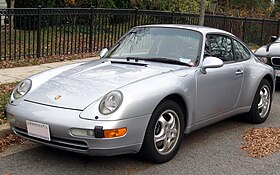Porsche 993
| Porsche 993 | |
|---|---|
 |
|
| Overview | |
| Manufacturer | Porsche |
| Also called |
Porsche 911 Porsche Carrera |
| Production | 1993–1998 |
| Assembly | Stuttgart, Germany |
| Designer | Tony Hatter (1991) |
| Body and chassis | |
| Class | Sports car (S) |
| Body style | 2-door coupé 2-door convertible 2-door Targa |
| Layout | RR layout/R4 layout |
| Powertrain | |
| Engine | 3.6 L air-cooled SOHC flat-six engine 3.8 L air cooled SOHC flat-six engine |
| Transmission | 4-speed automatic 5 & 6-speed manual |
| Dimensions | |
| Wheelbase | 89.45 in (2,272 mm) |
| Length | 1993-95: 167.7 in (4,260 mm) 1996-98: 167.7 in (4,260 mm) |
| Width | 1993-98 Coupé: 68.3 in (1,735 mm) 1993-95 Convertible: 69.9 in (1,775 mm) 1996-98 Convertible: 70.7 in (1,796 mm) |
| Height | 1993-95: 51.6 in (1,311 mm) Speedster: 50.4 in (1,280 mm) 1996-98: 51.8 in (1,316 mm) |
| Chronology | |
| Predecessor | Porsche 964 |
| Successor | Porsche 996 |
993 is the company's internal name for the version of the Porsche 911 model manufactured and sold between late 1993 and early 1998 (model years 1995-1998 in the United States), replacing the 964. Its discontinuation marked the end of air-cooled Porsches, with the 993 being not just the last air-cooled 911, but also the last of the hand built 911s.(multiple other Porsche 911 articles and the factory list the 964 as the "last hand built 911 and the most expensive production model". The 993 was a collaborative production with automation brought into the build process in order to reduce costs) The 993 generation of the 911 is often referred to as the best and most desirable of the 911 series, not only because of its beauty, but also because its performance is very good, even by modern standards, and the 993 was "the last complete 'modern classic'"; "the 993 was and forever will be that last fresh breath of air that Porsche gave the world; elegance and muscle all in one package." The book "Porsche 993 - Essential Companion" refers to the 993 as the "King of Porsche," and it is generally acknowledged as "The purists' Holy Grail."
The 993 was much improved over, and quite different from, its predecessor. Porsche said that every part of its engine was new, and only 20% of its parts were carried over from the previous generation. Porsche itself refers to the 993 as "a significant advance, not just from a technical, but also a visual perspective." Porsche's engineers devised a new light-alloy subframe with coil and wishbone suspension (an all new multi-link system), putting behind the previous lift-off oversteer and making significant progress with the engine and handling, creating a more civilized car with better than ever quality yet one in which the driving experienced remained uncompromised. The 993 was also the first 911 to receive a six speed gearbox.
Like previous and future generations of the Porsche 911, there were several variants of the car manufactured, varying in body style, engines, drivetrains and included equipment. Whereas the Porsche 964 produced 247 horsepower, the model year 1995 993 produced 272, and this was increased again in the model year 1996-1998 911s with the addition of the Varioram system, which added additional power, particularly in the mid-ranges, and also resulted in a more throaty noise at higher revs; as a consequence, the 1996-1998 Varioram 993s put out 285 horsepower. This resulted in a 15% increase in horsepower over its 964 predecessor.
The 993 was replaced by the Porsche 996. This represented a dramatic change for Porsche. As many enthusiasts agree, "the 993 is one of the sweetest spots in the 911's half-century of existence," and while "more modern versions might be more dynamically capable, they're bloated behemoths in comparison to the lean 993."
...
Wikipedia
